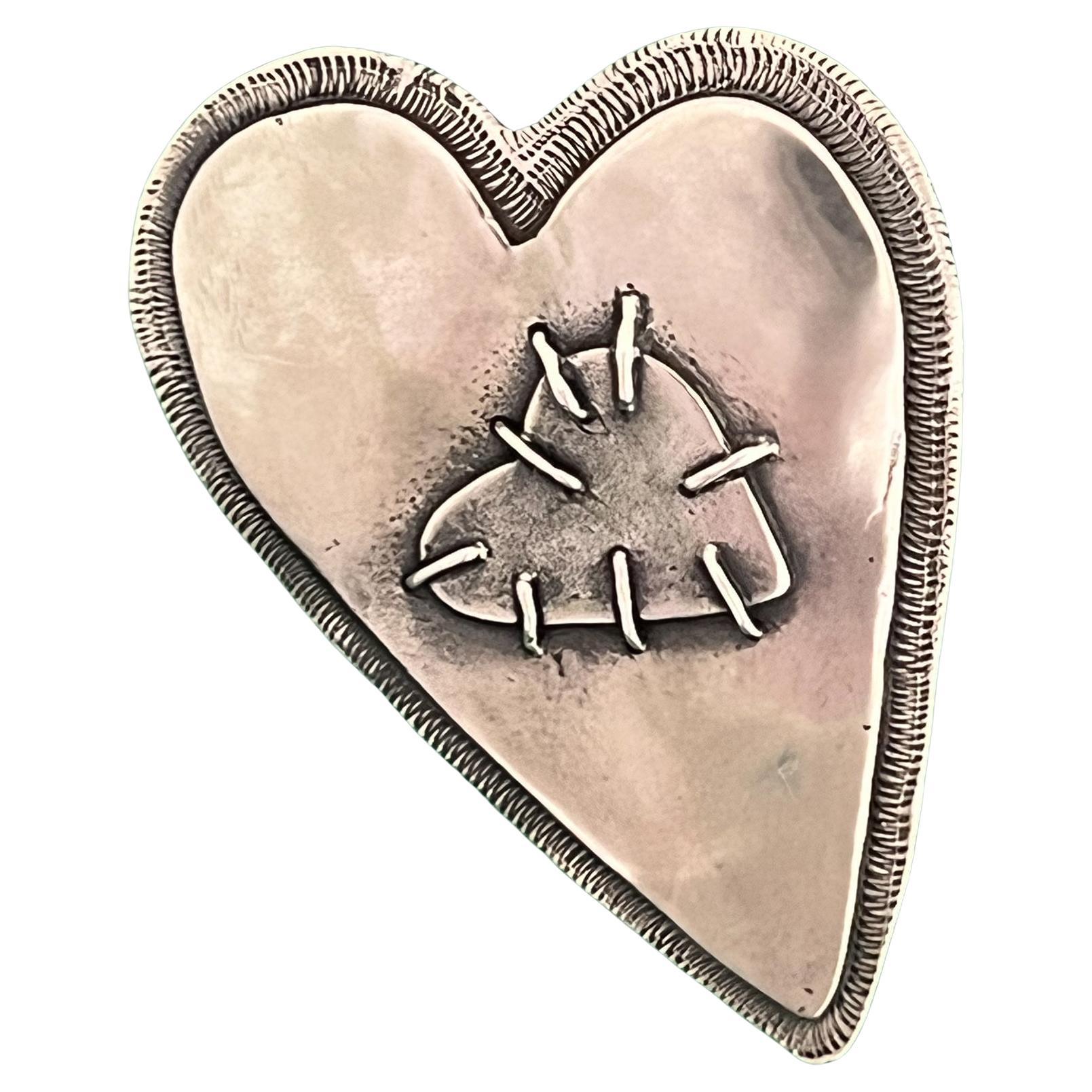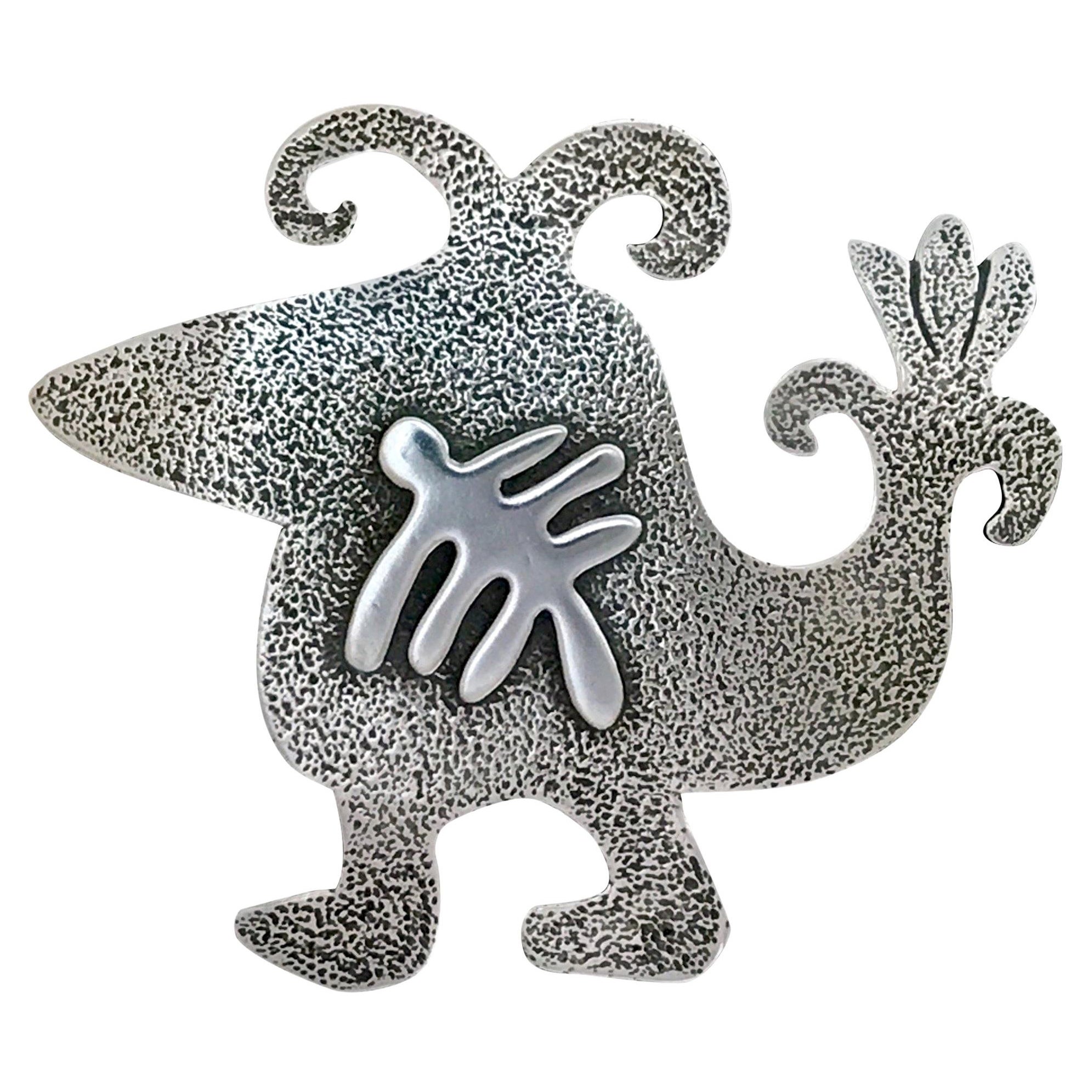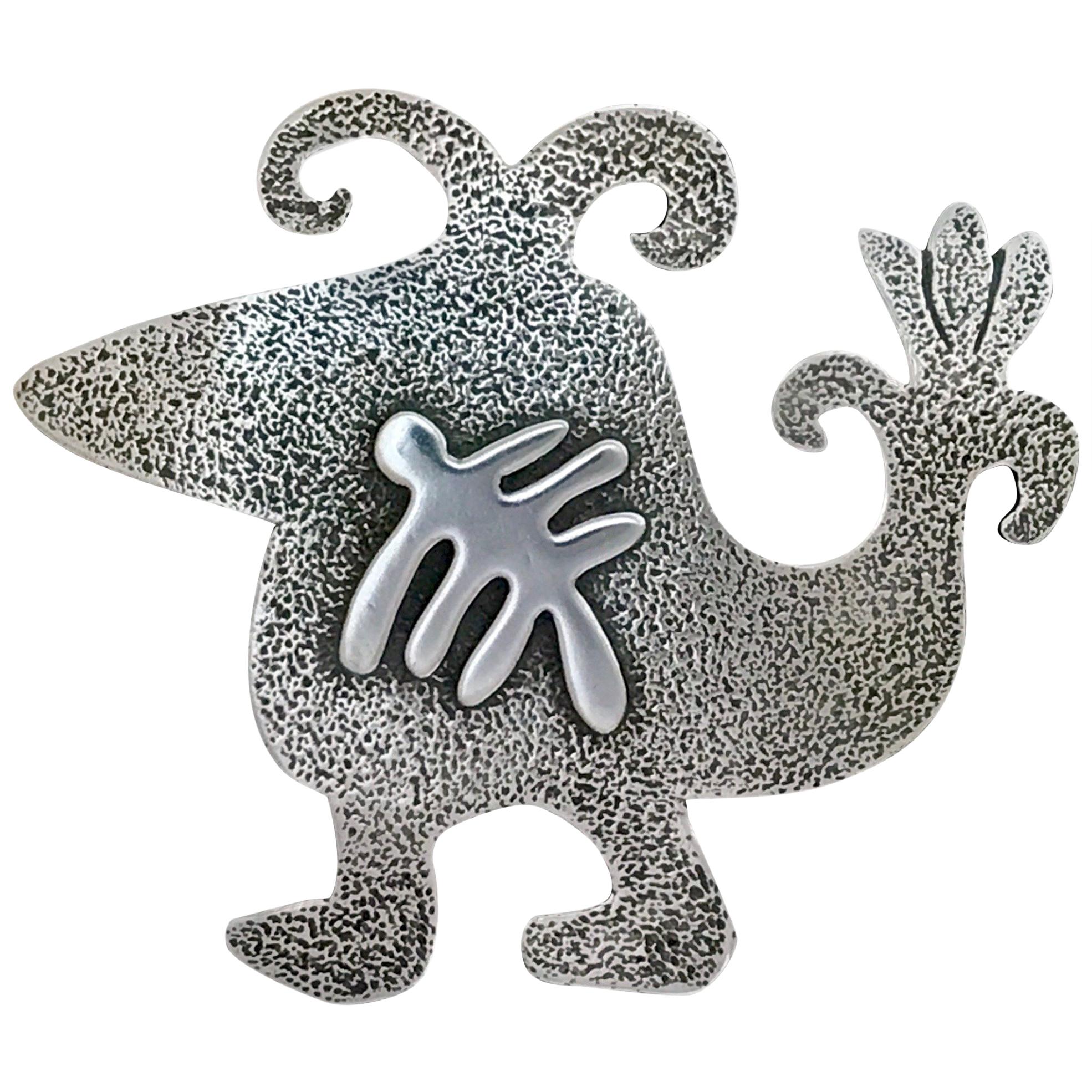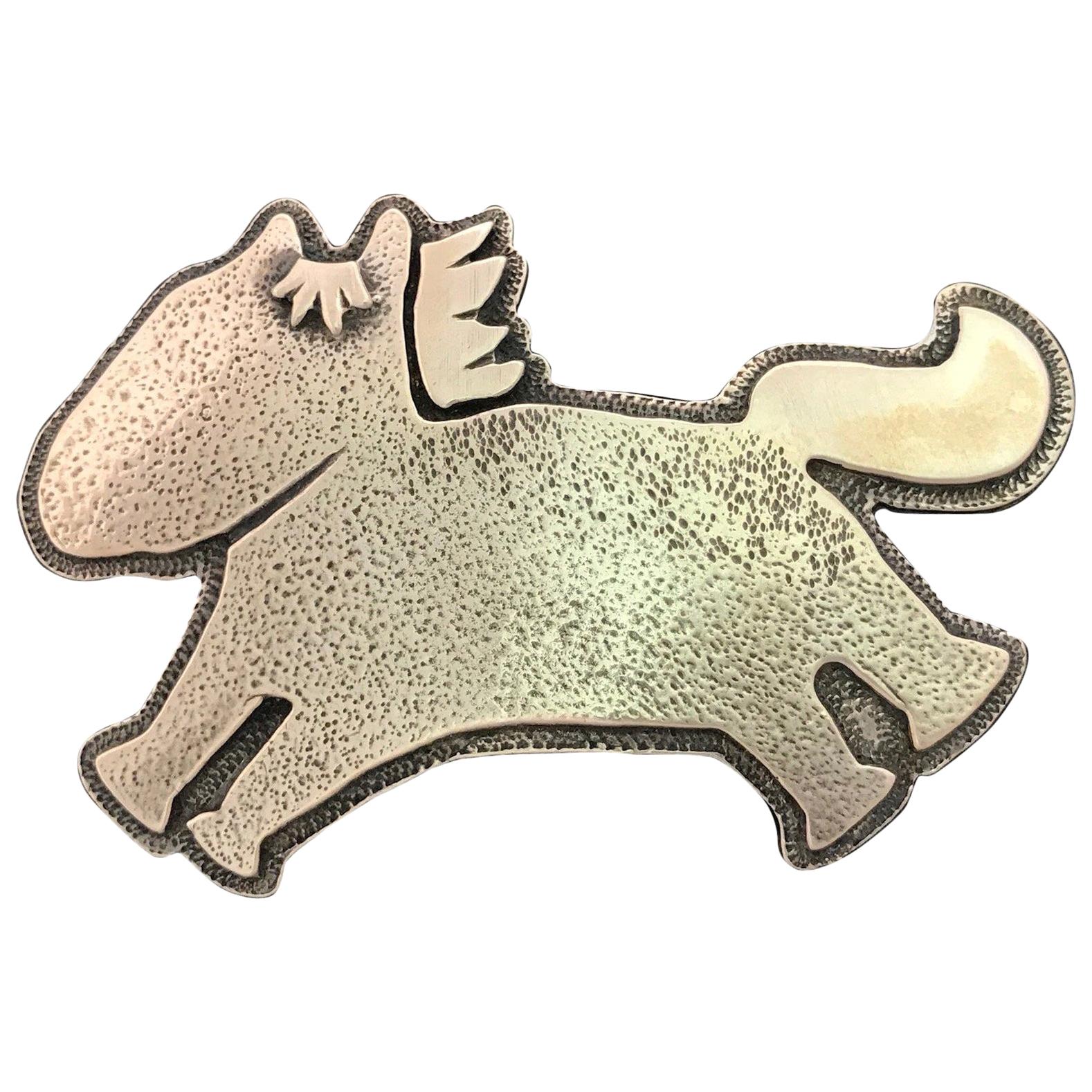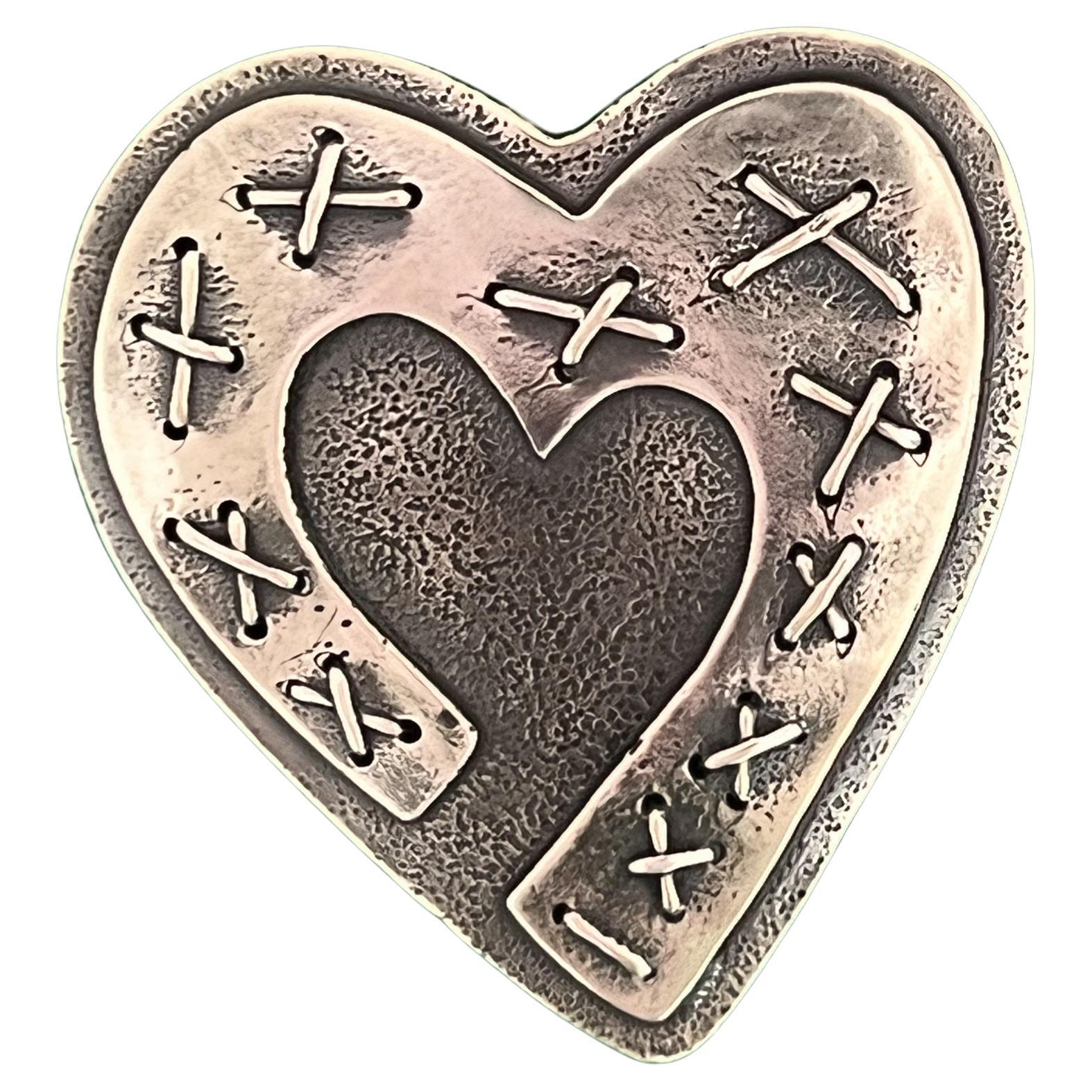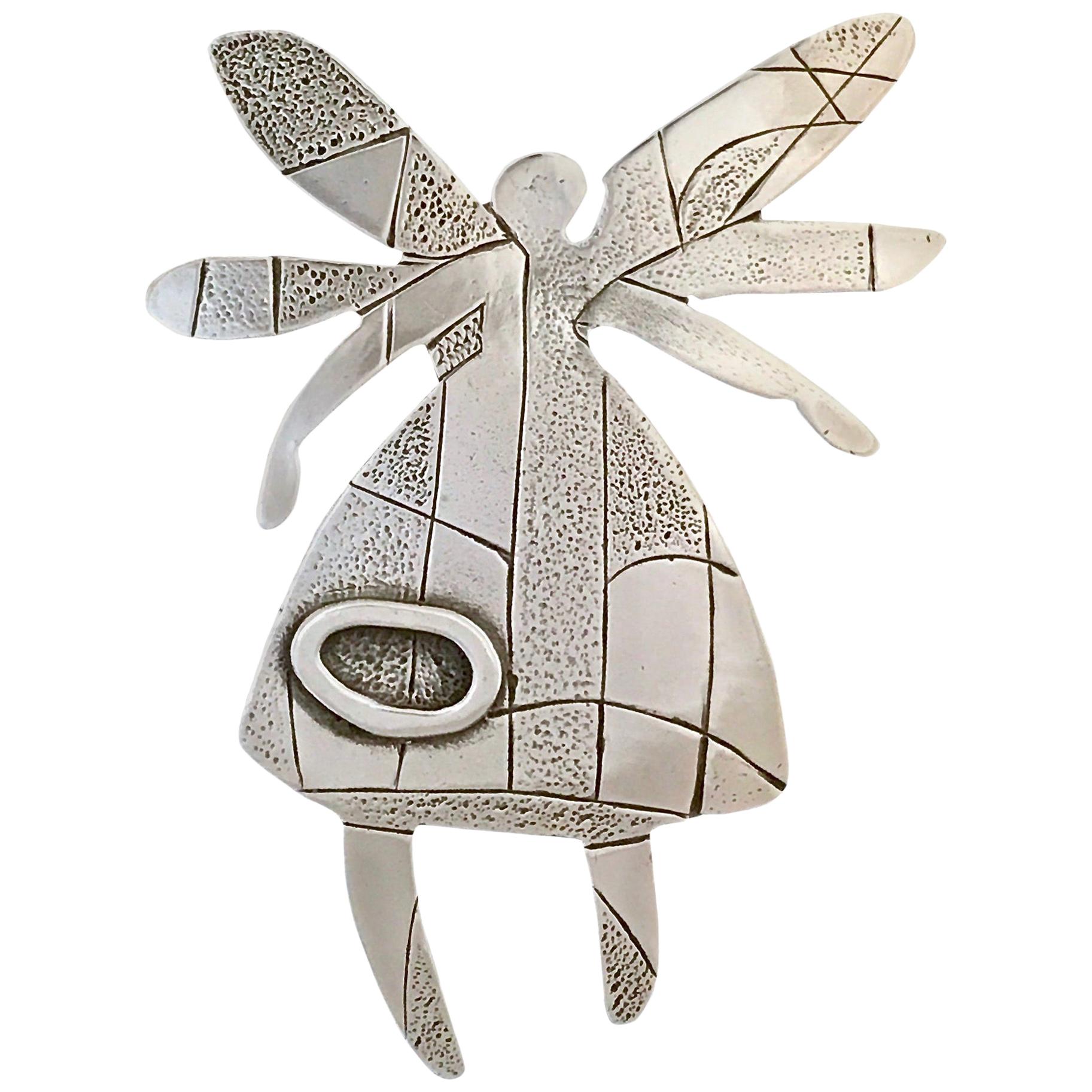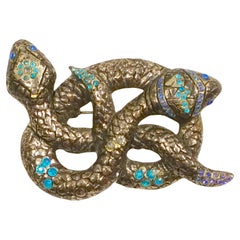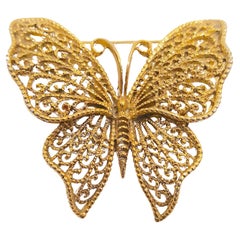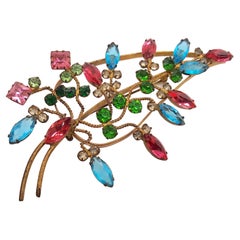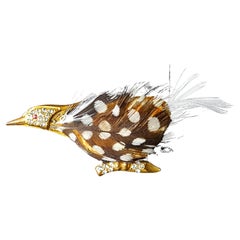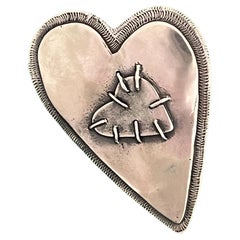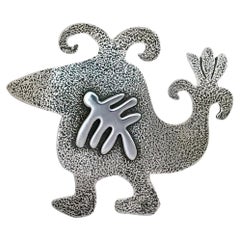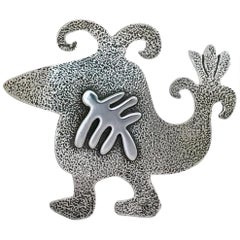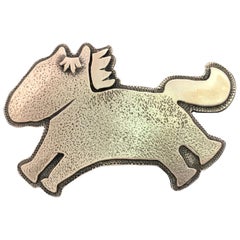Items Similar to Renaissance FleurDeLis Niello HighRelief GiltEngraved Heraldry Reliquary Jewelry
Want more images or videos?
Request additional images or videos from the seller
1 of 20
Renaissance FleurDeLis Niello HighRelief GiltEngraved Heraldry Reliquary Jewelry
About the Item
Demonstrating the epitome of miniature decorative art by Renaissance European goldsmiths who fashioned quatrefoil and/or cruciform jewelry with heraldry or religious symbols, this centuries-old intricately engraved gilt-copper-and-silver brooch, pendant or button/badge, which features a central niello fleur-de-lis surrounded by dense punchwork adorning its high-relief crossed bars, reflects the size, materials, construction and decoration of mid-to-late 15th-Century pieces of jewelry collected by leading museums.
Like our barbed-quatrefoil-shaped ornament, TheMet accession-17.190.967 pendant for its European Sculpture & Decorative Arts collection is a richly engraved gilt silver 3.8-cm ornament made by a goldsmith and decorated with niello in the shape of a barbed quatrefoil that is framed by highly textured motifs. Given its hollow center, the museum notes that it was possibly commissioned as a miniature reliquary in Northern Italy in the second half of the 15th Century.
Since the two bars that cross on the front of our hollow piece appear to symbolize the Christian crucifix, as well as Medieval peaked reliquary caskets that housed martyr relics, its elegant three-sectioned niello-inlaid engraving may be a crested staff representing the Holy Trinity. Further supporting that our piece is a reliquary, TheMet accession-17.190.499 portable Crucifix (see our photo) is a 15th-Century Italian intricately-engraved and niello-inlaid gilt silver-and-copper-over-wood processional cross featuring distinct multiple barbed quatrefoil sections, which had housed relics. Notice that our piece matches the elongated barbed quatrefoil at the center of the cross where the upper body of the dying Christ is depicted, which further suggests the religious symbolism of the shape.
For comparison to older 14th-Century gilt ornaments--whose figurative decoration is also clearly based on the Christian stories of the Crucification or the Christ-Mother--we included our photos taken of other museum pieces with some of our key elements. Two French gilt-copper pieces at the Louvre (accessions 0A 11981 and MRR 251) are decorated with champleve enamel (which could have disappeared from at least the base of our piece), while both have barbed quatrefoil shapes and high-relief elements like ours. Notice that one, which is noted to be about the virgin Christ-mother Annunciation by an angel, likewise has a central bar decorated with a fleur-de-lis as a symbol of the unborn Spirit.
Slightly smaller and more refined like ours, while dating to the mid-15th Century, TheMet accession-57.261 mostly gold brooch/pendant for The Cloisters collection has remarkably similar construction (see our photo of its back) with a multi-piece layered high-relief front decorated in multiple ways, and more so on the reverse where its backplate is pierced by a hook to act as a hidden bale, plus its c-clasp and T-bar hinge are directly soldered to the backplate and fasten with a sharp silver pin. The museum states that tiny brooches like these were often betrothal gifts given by the groom to the bride as tokens of love during courtship.
Our more versatile ornament can otherwise be vertically pinned to fasten a button loop with its hook, or flipped upside-down as a brooch (whereby the vertical fleur-de-lis will appear the same when positioned either way) to horizontally dangle another pendant when its hook is located on the bottom.
We also found in The British Museum collection even smaller c.1500s cast, high-relief, engraved, chased, soldered, layered, riveted and/or gilded English men’s-cap jewelry (such as the multiple “heraldry badges” photographed within the listings for accession numbers 2001,0701.1 & 2001,0703.1).
If our piece may not be a reliquary with something hidden inside or a marriage engagement gift, the 10mm-long black foliate decoration could otherwise represent such evolved heraldry since the fleur-de-lis was stylized in many European countries during the Renaissance to represent a family, army, or city. As a symbol of French conversion to Christianity, the French King Louis in the 12th Century made a fleur-de-lis element of the Holy Trinity vector into the official emblem of his royal authority on shields. Later, English kings adopted it when claiming the French throne. By the 14th Century, the fleur-de-lys was used in family insignia that was sewn onto a knight's coat-of-mail surcoat. This coat-of-arms insignia could identify them if found on a battlefield.
Beyond the punchwork found throughout the front of our piece like early Anglo-Saxon square-headed brooches, its intricate chasing features star-like rays, flowerheads, scroll-like waves, swirling clouds, and notched semi-circular curved edges. Such motifs had evolved from European ribbon-like curvilinear textures into much more refined representations by the mid-16th Century, as seen in the pen-and-ink designs found in the Jewellery Book drawn by Hans Holbein the Younger. His c.1532-43 works on paper at The British Museum detail motifs and cartouche-shapes resembling ours to be reproduced as men's clothing ornaments. According to museum-curator notes: “This type of jewelry finds its origins in the medieval pilgrim badge…the transition from this type to a fashionable male ornament is attributable to the arrival of the French king, Charles VIII, into Naples in February 1495. On his cap, the king wore a gold circular jewel and his men had similar jewels (though not of gold) on their caps or sleeves. The Italians soon adopted this fashion and it then spread north reaching most European courts.”
Based on construction seen in Renaissance men's-cap ornaments in the collection of The British Museum photos (“dress-hooks” accession #s 2002,0712.1 & 2001,1105.1), the hook that pierced the center of our ornament’s backplate near its top likely has a hidden recurving other end like an S-shape that is soldered to the underside of the possibly hollow rectangular bar on the front. This central 5mm-wide bar acts like a rivet to sandwich the 10mm-wide double-peaked smooth cast bar in between. Similar clothing ornaments are detailed in the 2017-published book, Bejeweled: Men and Jewelry in Tudor and Jacobian England, by Awais-Dean.
As signs of age and use, our good-condition brooch/pendant has minute oxidation and dark spots, along with a front hair-line scratch across a textured edge and a pinpoint indentation at the side peak of one of the bars. These are not visible with the naked eye, while they are apparent in our closeups. The spots of verdigris and white-metal indicate the metal beneath the gilding.
We took some of the photos in natural light to best show the metallic colors. While the brooch/pendant has red tones associated with copper in some light, it otherwise appears matte gold.
The ornament had been a family heirloom found at a U.S. estate in New York without any shared history.
- Metal:Gilt Metal,Niello,Silver,Copper
- Weight:6.88 g
- Dimensions:Height: 1 in (25.4 mm)Width: 1.5 in (38.1 mm)Depth: 0.5 in (12.7 mm)
- Style:Renaissance
- Place of Origin:Europe
- Period:16th Century
- Date of Manufacture:1450-1550
- Condition:Wear consistent with age and use.
- Seller Location:Chicago, IL
- Reference Number:1stDibs: LU3244219297952
About the Seller
5.0
Gold Seller
Premium sellers maintaining a 4.3+ rating and 24-hour response times
Established in 2012
1stDibs seller since 2022
25 sales on 1stDibs
Typical response time: 4 hours
- ShippingRetrieving quote...Shipping from: North Adams, MA
- Return Policy
Authenticity Guarantee
In the unlikely event there’s an issue with an item’s authenticity, contact us within 1 year for a full refund. DetailsMoney-Back Guarantee
If your item is not as described, is damaged in transit, or does not arrive, contact us within 7 days for a full refund. Details24-Hour Cancellation
You have a 24-hour grace period in which to reconsider your purchase, with no questions asked.Vetted Professional Sellers
Our world-class sellers must adhere to strict standards for service and quality, maintaining the integrity of our listings.Price-Match Guarantee
If you find that a seller listed the same item for a lower price elsewhere, we’ll match it.Trusted Global Delivery
Our best-in-class carrier network provides specialized shipping options worldwide, including custom delivery.More From This Seller
View AllAntique ArtNouveau Austria Scheid RareMark Pave BlueZircon Silver Snake Brooch
By Georg Adam Scheid
Located in Chicago, IL
During the Art-Nouveau period while German-born Vienna-based silversmith, niello master, and entrepreneur Georg Adam Scheid (1837-1921) was prospering from a related refinery busines...
Category
Early 20th Century Austrian Victorian Brooches
Materials
Aquamarine, Diamond, Sapphire, Zircon, Silver, Sterling Silver
MiriamHaskell WWII Era GoldGilt Filigree Cast Butterfly FrankHess Pre1945 Brooch
By Frank Hess for Miriam Haskell
Located in Chicago, IL
A child of the Art-Nouveau period, Miriam Haskell loved its butterfly design-motifs, which are found in many pieces of costume jewelry by her first designer Frank Hess. His butterfly...
Category
Vintage 1940s American Art Nouveau Brooches
Materials
Yellow Gold, Gilt Metal, Base Metal
Henry Schreiner 1930s ProngSetCrystal Flora Spray Paisley Shadow Box Gilt Brooch
By Henry Schreiner
Located in Chicago, IL
Henry Schreiner, the Austrian-born blacksmith founder of Schreiner New York in 1932, handcrafted this multi-color prong-set Bavarian-crystal, stylized-flora spray, gold-gilt brass br...
Category
Vintage 1930s American Artist Brooches
Materials
Crystal, Brass, Yellow Gold, Gilt Metal
Couture 1938 France Depose ElsaSchiaparelli Pagan FeatherCrystalGold Bird Brooch
By Elsa Schiaparelli
Located in Chicago, IL
Unusually decorated with small partridge feathers like the yellow-gold gilt necklace commissioned by Elsa Schiaparelli (1890-1973) that is featured on the front-and-back covers and centerfold of the French costume-jewelry hardcover book Lina Baretti Parures authored by Patrick Mauries, this unique pave-crystal yellow-gold gilt metal partridge-on-a-branch brooch is further distinguished as an unsigned Parisian-couture piece for Italian-born Schiaparelli with its combination of embossed text "Made In France" and "Modele Depose", along with the trombone clasp often used in the early 20th Century for custom-made French small brooches.
The book centerfold on pages 90-91 shows a closeup of the feathered necklace created by French-born Corsican Baretti, whose intricate decoration often mixed ready-made textural or shiny materials like velvet, cork, wire, rhodoid or raffia with custom-made metal, plastic or glass by specialized Parisian workshops such as Maison Gripoix. The Baretti-book caption about the attributed necklace notes: "Collier realise pour Elsa Schiaparelli. Liege, soie, cannetille, perles de verre et plumes de perdix. Chaine en metal." While none of the captions date this necklace--which could have been from the same commission as our brooch--Baretti created one-of-a-kind jewelry for Schiaparelli from the 1930s to the early 1950s until the fashion designer retired.
Our brooch was most likely made for a fashion-show debut of one of Schiaparelli's themed clothing collections in the late 1930s for which she commissioned many costume-jewelry paruriers including Baretti. See our photo of a Schiaparelli 1930s...
Category
Vintage 1930s French Artisan Brooches
Materials
Crystal, Gold, Yellow Gold, Gilt Metal
MiriamHaskell WWII PurpleGlassFlowers GoldLeaves WiredPlasticBack Pre1945 Brooch
By Frank Hess for Miriam Haskell
Located in Chicago, IL
Beginning in 1939, Miriam Haskell asked her first costume-jewelry designer Frank Hess to spare the use of metal during WWII while war materials were needed in the United States. So t...
Category
Vintage 1940s American Baroque Revival Brooches
Materials
Mixed Metal
1941 ChanelRelevant American Reinad ArtDecoStyle Silver PolkaDot LargeBow Brooch
By Reinad
Located in Chicago, IL
In Spring 1941 after French fashion couturier Gabrielle "Coco" Chanel had stopped production of her clothing designs while she remained in Europe during the WWII era, the decades-old American costume-jewelry company Reinad began imprinting pieces in its new retail line, Chanel Novelty Co, with the script signature "Chanel". As this was prior to the use of the sans-serif capital-letter signature "CHANEL" on French-made jewelry that was commissioned by the Parisian designer, as well as before U.S.-copyright protection began in 1955, the House of Chanel that was mostly owned by the Jewish Wertheimer family of venture capitalists (who remarkably still produced Parfums CHANEL and French-vineyard wine via legal proxy while they lived in asylum in The States during the war) filed a U.S. lawsuit to demand that Reinad halt the use of its founder's famous last name.
As the Werthheimers' quickly won, Reinad only produced the single seasonal collection stamped with the French brand name, and subsequently only imprinted its company name as the sans-serif capital-letter signature "REINAD" without a copyright symbol, which was different that its prior signatures dating back to its founding in 1922. When Chanel herself resumed French-made fashion production in Paris in 1953 (with Werthheimer support leading to their acquisition of all rights to her name despite her post-war eight-year exile in Switzerland due to close association with Nazis), for the first time all of her creations were signed "CHANEL" like the original packaging of the exceedingly profitable "No.5" perfume.
While Reinad continued to produced costume jewelry until 1954, in the last decade of this business, the U.S. company continued to try to appeal to potential Chanel buyers by at least making Chanel-style designs. As such, owning an attractive and well-made Reinad piece can be considered a useful investment in fashion history as evidence of a little-known turning-point involving the most famous ongoing luxury-fashion business Chanel, as well as of the impact of that legal judgement had on advancing U.S. design protection for brands that later used the copyright symbol.
Like early ArtDeco-style oversized heavy metallic costume jewelry by Chanel, this three-dimensional monochrome silver-alloy polkadot bow brooch imitates a pale polkadot-textured ribbon. Notably, while high-quality ribbon for styling hair or decorating clothing in a non-functional way was still an expensive accessory...
Category
Vintage 1940s American Art Deco Brooches
Materials
Rhodium, Silver, Base Metal
You May Also Like
Two Hearts, by Kerry Green, sterling silver, pin, pendant, cast, layered, stitch
Located in Santa Fe, NM
Two Hearts, by Kerry Green, sterling silver, pin, pendant, cast, layered, stitch
Artist jewelry collection from Santa Fe, New Mexico. Cast sterling sil...
Category
2010s American Contemporary Brooches
Materials
Sterling Silver
$575 / item
Free Shipping
Little Jack, cast silver, pin, pendant, bird, dragonfly, Melanie Yazzie, sweet
By Melanie Yazzie
Located in Santa Fe, NM
Little Jack, cast silver pin pendant bird dragonfly Melanie Yazzie
Melanie A. Yazzie (Navajo-Diné) is a highly regarded multimedia artist known for her printmaking, paintings, scul...
Category
2010s American Contemporary Brooches
Materials
Sterling Silver
Little Jack, cast silver pin pendant bird dragonfly Melanie Yazzie
By Melanie Yazzie
Located in Santa Fe, NM
Little Jack, cast silver pin pendant bird dragonfly Melanie Yazzie
Melanie A. Yazzie (Navajo-Diné) is a highly regarded multimedia artist known for her printmaking, paintings, scul...
Category
2010s American Contemporary Brooches
Materials
Sterling Silver
Beverly Hills Yazzie, sterling silver pendant Melanie Yazzie Horse Navajo
By Melanie Yazzie
Located in Santa Fe, NM
Beverly Hills Yazzie, sterling silver pendant Melanie Yazzie Horse Navajo
Also available with a pin back. Contact us for information.
Wearable art jewelry designs...
Category
2010s American Native American Brooches
Materials
Sterling Silver
Mended by Kerry Green, sterling silver, pin, pendant, valentine, heart, modern
Located in Santa Fe, NM
Mended, Heart by Kerry Green, sterling silver, pin, pendant, layered, stitched, modern
Artist jewelry line, ready to wear as a pin or pendant. Made in ...
Category
2010s American Contemporary Brooches
Materials
Sterling Silver
$475 / item
Free Shipping
Bitter Water Girl by Melanie Yazzie, cast silver pendant enhancer fairy Navajo
By Melanie Yazzie
Located in Santa Fe, NM
Melanie A. Yazzie ™: jewelry
BITTER WATER GIRL
sterling silver enhancer
3” h x 2” w
Pendant/enhancer cast sterling silver. Gently slide the enhancer over b...
Category
2010s American Contemporary Pendant Necklaces
Materials
Silver, Sterling Silver
Recently Viewed
View AllMore Ways To Browse
16th Century Antiques
Renaissance Copper
Quatrefoil Jewellery
16th France Renaissance
12th Century Jewelry
14th Century
16th Century Dress
Antique Clothing Museum
Antique Religious Jewelry
Antique Copper Hinges
Estate Cross Jewelry
Copper Relief Sculpture
Antique 16Th Century Jewelry
Antique Christian Jewelry
Antique Medieval Jewelry
Dior Coat S
Gilt Casket
Metal Ribbon Sculpture
